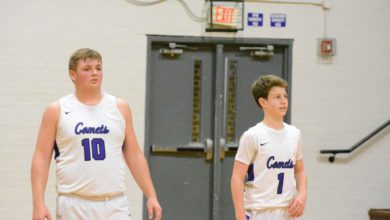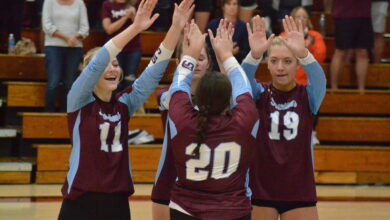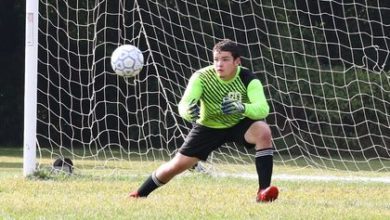Declining high school football numbers cause pause at Mahomet-Seymour and St. Joseph-Ogden
By FRED KRONER
fred@mahometnews.com
National trends in athletics are playing out in a similar pattern in east central Illinois.
For more than a decade, participation in high school football has been declining.
“I believe in the 2004 season we had 106 players,” M-S football head coach Keith Pogue said.
“That’s the highest I can recall.”
This year’s M-S roster originally had 72 players, counting the ninth-graders.
“We recruited six more freshmen,” Pogue said.
That brought the Bulldogs’ total to 78.
At St. Joseph-Ogden this fall, there were 63 players at all levels.
In 1999, under former coach Dick Duval, there were 91 squad members.
The National Federation of State High School Associations has charted participation numbers for decades.
Their statistics show a decline for football in Illinois of more than 20 percent between 2008 and 2017.
In 2008, there were 50,956 high school students in the state participating in football.
In 2017, the total dipped to 40,111.
Pogue sees two major factors for the steady decline in football.
“The ugly truth about football at the scholastic level is the concussion issue has deterred many from coming out,” Pogue said. “I think coaches who do not acknowledge the potentially life-changing injuries that can come with head injuries are doing the game a tremendous disservice.
“One of the reasons I have kept coaching this long is I want to be a head coach who reads the research and responds in practice. Coaches denying there is a problem are not helping.”
For Pogue, that means not continuing to do things the way they have been done for years, if not for decades.
“We have changed the way we block and tackle,” he said. “We have changed our practice schedule. We have changed our off-season regimen.
“All of this in response to head injury research. It is incumbent on coaches to make the game as safe as possible for players. I applaud the current rule changes and want to see us go further in changing the rules of the game to make it safer.
“If my son was playing football, and I do have one on the team currently, I would want a coach who thinks about the head injury issue constantly, not a coach who pretends it is a made-up problem.”
The other issue, Pogue said, has nothing to do with the possibility of injuries.
“The head injury risks are just part of the picture,” Pogue said. “The majority of kids are choosing not to do athletics before they turn 13.
“The big four of youth sports, tackle and flag football, soccer, basketball and baseball all saw a precipitous decline in numbers from 2008 to 2016.”
National recruiting services are fostering the need for specialization by scouting and providing national attention to middle school athletes.
Some students enter high school with scholarship offers from a Division I university before they have played their first prep game.
To reach that level, devotion to a particular sport is paramount.
“The emphasis on training for one sport and super-competitive youth sports is driving kids away,” Pogue said. “One study from earlier this year said 37 percent of players would rather their parents not attend their games.
“That’s incredibly sad, and I think reflects that way too much pressure is being put on kids way too early. The kids going out for sports are doing fewer sports and specializing.
“This continues, despite college coaches stating repeatedly they want multi-sport athletes. Changes in youth sports and parental attitudes make it tougher than ever to get kids to try a new sport.”
Pogue said some students are more susceptible to the travel team journey.
“The kid with means is specializing and getting sucked into all of the youth sports business complex and the kid without means is getting left behind,” he said. “It has not hit football to the same level as some other sports, but it is coming with elite 7-on-7 teams, individual strength trainers, and the like.”
SJ-O football coach Shawn Skinner said it’s a misnomer to think football is the primary sport where the potential for injuries exist.
“First and foremost is the concept that the sport’s not safe. That could not be further from the truth,” Skinner said. “No other sport has devoted as much resources from equipment to coaches teaching better/safer play and rules promoting safety than our sport.
“Go and examine what other sports are doing and they are making their sports more dangerous.”
It doesn’t take much of an effort to find examples, Skinner said.
“Softball/baseball allow metal cleats and have bats that generate exit velocity in the triple digits at the high school setting,” he said. “Wrestling allows participants to go without headgear, and they allow kids to wrestle as many as seven times in a day.
“Soccer has zero issue with players/teams playing multiple games in a day or in a row. No headgear required of players in softball/baseball/soccer because the IHSA/NFHS can’t get a company to back a face mask/helmet from a safety/insurance standpoint. Where is the best practice and safety concern in these sports?”
Skinner said in some ways youth sports and the burgeoning number of travel teams are doing pre-teen athletes a disservice.
“The other issue comes from playing time,” he said. “Parents/players get so accustomed to starting and playing in any travel team they play for.
“Kids do not want to wait their turn to be a varsity starter. The attitude of today’s world is ‘I want what I want and I want it now. If I can’t, then I will quit or I will simply make another team up and I will start for that team.’
“It’s difficult to go from being a starter to having to wait to be a ‘prime time’ player.”
The need to work hard and earn a starting position can become less of a priority for some.
“And yet, isn’t that what is supposed to be great about sports?” Skinner wondered. “Sports is supposed to help us understand the way life works.
“We don’t always get what we want as soon as we want it. Those that are willing to work and withstand difficult times will be better off in the long run for it.
“Society today doesn’t embrace the grit that comes from struggles.”
Football exemplifies that toughness.
“But that’s why football matters,” Skinner added. “As a coach, I believe that’s my first job, to help mold these players into being the best young adults they can be through the experiences that we face.
“I naturally want to win — but if we do things the right way and if we work — things have a way of working out for people who embrace that kind of mentality.”
An IHSA rule change that will be put into play in 2019 could have an adverse effect, Skinner believes.
An athlete who plays in a football game on one day, must be withheld from contact the next day.
Skinner believes this plan will create unintended consequences which could mean the elimination of a lower-level team, either the freshmen or the junior varsity.
“There is no way we can play a JV game on Monday and those kids not participate in practice in some capacity the next day,” Skinner said. “As the rule states, if a player plays in one play in a game they can’t participate in contact for one full day.
“So anyone who plays in a JV game on Monday would not practice on Tuesday. The same is true for a freshman who plays on a Thursday. That kid now would not be allowed to get on the field, even for a kickoff, on Friday night.
“This is another example of over-policing the sport and not allowing coaches to do what’s best.”
Even though Skinner said, “I’m not a fan of the new rule,” SJ-O will follow the mandatory changes.
“I fear this rule will have more repercussions to it than anything else we have seen,” Skinner said. “We will adjust, but it’s going to eliminate one full lower level team, and that isn’t good for any of the programs/schools in our lower classes.”
At a time when coaches are attempting to raise participation numbers, the likelihood of fewer games could be a deterrent to progress.
Skinner’s point helps illustrate one of the ironies Mahomet-Seymour discovered when changing athletic conferences after the 2016-17 school year.
“One of the reasons we left the Corn Belt is those teams were canceling a lot of lower level games,” Pogue said. “Mr. (Matt) Hensley, our A.D., and I were left scrambling to fill those schedules to get games for those kids.
“We thought a move to a conference with bigger teams would alleviate some of those problems.
That has not been the case.”
This season, however, just three teams in the Apollo Conference are fielding teams at all three levels: Mahomet-Seymour, Mount Zion, and Taylorville.
“We have the second most kids out for football in the conference (behind Mount Zion),” Pogue said. “Once again we are scrambling for lower level games.
“Mr. Hensley has done an exemplary job of working to get us games for those kids.”
A mitigating factor at both M-S and SJ-O is the number of options for boys in the fall. Besides football, each school offers cross-country, golf and soccer.
At M-S, there are 79 boys competing in fall sports other than football.
At SJ-O — where the enrollment of 467 is about half of M-S’ student population of 919 — that number is 42.
“I am sure fall sports have some effect on our numbers,” Pogue said, “but overall I would say it is quite minimal.
“There are a couple of boys in golf this year that could help us, but really soccer has become a year-round endeavor and those kids don’t do a lot of other sports. I’m not sure we lose many players to soccer at all.
“I would put the total number of kids we lose to other fall sports closer to 10.”
From Skinner’s view, the same is true at SJ-O.
“It’s very tough to be everything to everyone,” he said. “Having football, cross-country, soccer and golf means our kids have many options, but I would agree there are a few kids — maybe four to 10 — that would probably have played football as an option.
“However, I will say this about our sport, it is work and it is an acquired taste to participate in.
“Those who play football are a part of a special fraternity to me. They are willing to put themselves in a hard-working environment and I think the rewards for that are the ability to handle the trials and experiences that we all face in life with just a little bit better resiliency. At least I hope that’s what our players leave us with.”
Interestingly, while the National Federation charts yearly declines in football, not all high school sports are taking a hit.
In an August press release, the National Federation stated, “the overall number of participants in high school sports increased for the 29th consecutive year in 2017-18.”
Among boys’ sports, the National Federation said two running sports showed the largest increases and both are fall sports in Illinois: soccer grew nationally by 6,128 participants, followed by cross-country with 3,824 newcomers.
Despite the losses in football, it remains far and away the most popular choice, both in Illinois and across the United States.
Last school year, 11-player football nationally had 1,036,842 participants. The next most popular sports was boys’ outdoor track and field with 600,097.
By contrast, those numbers in 2008-09 were 1,113,062 and 558,007, respectively.
The National Federation noted another key point.
While the numbers in 11-player football are down, participation in six-player and eight-player football continued to trend upward, according to the press release.
Pogue said that M-S is not going to accept declining numbers without making an effort to grow the sport.
“Our staff at the high school have set a goal to get 90 boys out for football next year,” he said. “We’re going to do everything we can to engage these young people.
“Our greatest assets are our current players. They need to be our best recruiters. We need to make sure every young man that comes to Mahomet-Seymour sees football as a fun and caring environment they can be part of.
“We need to reach out in new ways to kids and bring them into our family. The brotherhood and lifelong bonds that develop on a football team are unique and I want as many to experience it as possible.”
Part of the project includes education.
“We need to reach out to our community to show we are on the cutting age of safety and that is always our No. 1 priority,” Pogue said. “We have to sell our program, because kids no longer just walk in the school wanting to play football.
“I don’t know if we have the solution, but we will not fail for lack of continuing effort.”
Skinner agreed that football coaches need to continue to showcase the positives.
“Our numbers will improve if the parents and kids see value in participating,” Skinner said. “We are evolving as coaches/teachers in our sport. We have to continue to work to ensure there is an interest.
“I have no issues with the changes we are examining in our sport. But I do have issues with the constant negative media coverage when in fact we are doing more to improve our sport than at any time since President (Theodore) Roosevelt stepped in and saved the sport in its early stages at the beginning of the 20th century.”





